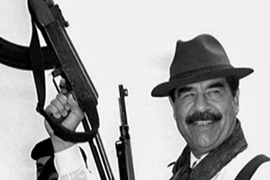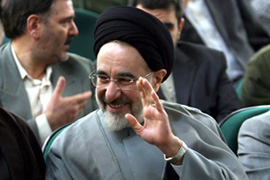Timeline: Arab-Iranian relations
Territorial conflicts and US influence have kept Tehran and its neighbours apart.

 |
| Relations between Iran and the Arab World deteriorated after the 1979 Islamic revolution [GETTY] |
Iran and its Arab neighbours have maintained a wary, yet stable relationship throughout the 20th century. However, relations deteriorated rapidly during and after the Islamic Revolution in 1979.
Neighbours such as Iraq, Kuwait, Saudi Arabia and Bahrain accused Iran of inciting their Shia minorities. When Iraq invaded Iran in 1980, Saddam Hussein, Iraq’s former president, repeatedly said he was fighting on behalf of Arab states against “Persian expansionism”.
Since the US-led invasion of Iraq in 2003, relations between Iran and the Arabs have plummeted even further. In 2005, as sectarianism appeared to threaten Iraq with civil war, Saud al-Faisal, Saudi Arabia’s foreign minister, said US policy in the country was benefiting Iran.
“We fought a war together to keep Iran out of Iraq after Iraq was driven out of Kuwait. Now we are handing the whole country over to Iran without reason,” al-Faisal said.
Relations between Iran and the Shia Hezbollah movement of Lebanon on the one hand, and Egypt, Jordan, and Saudi Arabia, on the other, reached boiling point in July 2006 when Tehran accused the Arab states of allowing Israel to invade Lebanon.
In late 2007, relations between Iran and the Arabs suddenly changed with foreign ministers exchanging visits to better ties and sign business and security pacts.
Growing influence
 |
| Ahmadinejad attended the opening of the GCC summit in Doha in December 2007 [AFP] |
In the years following the defeat of Iraqi forces in Kuwait, the US adopted a dual containment policy targeting Iran and Iraq. Nevertheless, Iranian leaders began a new wave of diplomacy to improve relations with Arab governments.
Once considered a hostile neighbour, Iran has seen its influence grow in the Middle East.
In recent years, it has supported movements countering what it calls US interventionist policy.
Iran is known to support Hezbollah in Lebanon, Hamas in the Gaza Strip, and according to the US military, Shia militias in Iraq.
As a result, Iran is now regarded as a major player in the geopolitics of the Middle East.
The inclusion of Mahmoud Ahmadinejad, the Iranian president, in the meeting of the Gulf Co-operation Council (GCC) summit in Doha, Qatar in 2007 reflected a concerted effort on the part of Arab states to recognise Tehran’s influence as a rising power.
Fahmy Howeidy, an Egyptian scholar and expert on Iran, believes recent conflicts, including the Iraq war, have elevated Tehran’s importance in the region.
“For one, no one can talk about the Iraqi file without mentioning Iran. Iran is also involved in the Lebanese and Afghani files [and] it has connections with the Syrians, the Palestinians. Thus, if anyone wants to reach a settlement in the region, he should approach Iran,” he told Al Jazeera.
More recently, however, ties between some Arab states and Iran deteriorated after the Israeli war on Gaza in December 2008. Iran accused Egypt and Jordan of co-operating with Israel’s closure of the Gaza Strip.
Timeline: Arabs and Iran
1969: Iran drops its claim on Bahrain.
1971: Iranian forces occupy three islands, including the strategic island of Abu Musa at the entrance of the Strait of Hormuz, claimed by both Tehran and the United Arab Emirates. The UAE agrees to share control of Abu Musa but continues to call for the return of the other two islands – the Lesser Tunb and the Greater Tunb.
March 1975: Iraq and Iran sign an agreement mediated by Algeria ending all outstanding border disputes. Iraq makes territorial concessions, chiefly relinquishing demands for the Shatt-al-Arab waterway shared by both countries in the Gulf. In return, Iran stops supplying Kurdish separatists with arms and money for their war against Baghdad.
October 1978: In further observance of the 1975 agreement, Iraq’s government asks Ayatollah Khomeini, the leading Iranian cleric, to leave Najaf after spending 14 years in exile in the country. Khomeini leaves for Kuwait where he is denied entry and diverted to Paris.
January 1979: Mohammed Reza Pahlavi, the Shah of Iran, is ousted from power. Anwar Sadat, Egypt’s president, angered Khomeini by providing a home for the exiled shah. Iran then severed all ties with Egypt.
February 1979: Khomeini returns to Tehran and is installed as leader and founder of the Islamic Republic of Iran.
November 1979: Iranian students storm the US embassy and take several Americans hostage. The siege lasts 444 days and comes to be known as the Iran Hostage Crisis.
 |
| Iran blamed Egypt and other Arab states for siding with Iraq in the 1980s war [ARCHIVE] |
September 1980: Khomeini calls for Iraq’s Shia to rise up against the Saddam Hussein government. Saddam responds by annulling the 1975 Algiers Agreement. Both countries shell each others’ borders. Iraqi military forces invade on September 22.
Saddam says he is fighting Iran on behalf of other Arab states, who viewed the country as a threat to stability.
Almost all Arab countries, except Syria and Libya, support Iraq logistically and financially.
1980: The UAE submits its claims on Abu Musa to the UN. In the same year, Qatar, UAE, Kuwait, Oman, Saudi Arabia, and Bahrain form the Gulf Co-operation Council in response to Iranian threats.
October 1981: Anwar Sadat is assassinated by Islamic Jihad members. Iran symbolically renames a Tehran street in honour of Khaled el-Islambouli, Sadat’s assassin.
July 1987: More than 400 Iranian pilgrims are killed during the Hajj in Mecca when they clash with Saudi security forces during an anti-Iraq and anti-US demonstration.
Saudi Arabia later severs ties with Iran.
July 1988: While protecting Kuwaiti oil tankers in the Gulf, US Navy cruiser Vincennes shoots down an Iranian civilian airliner killing 290 passengers.
August 1988: Iran and Iraq sign a UN-brokered ceasefire ending their war. Some two million soldiers and civilians are killed and wounded during the eight-year conflict.
July 1989: Saudi authorities execute 16 Kuwaiti Shias alleging that they plotted a number of bombings which killed two pilgrims in Mecca. Riyadh blames Tehran for the attacks.
August 1990: Iraq invades Kuwait. Iranian policy-makers opt for non-involvement.
January 1991: Saddam Hussein revisits the Algiers agreement and concedes the Shatt-al-Arab waterway to Iran.
Later that year, Iran and Saudi Arabia re-establish diplomatic ties.
April 1992: Iranian forces take full control of Abu Musa.
1996: Iran begins to build a runway in Abu Musa and a power station on Greater Tunb.
 |
| Khatami sought warmer relations with Iran’s Arab neighbours [EPA] |
1997: Mohammad Khatami, considered a reformist among Iran’s ruling clergy, is elected president in a landslide win. He immediately embarks on a foreign policy agenda to mend ties with the US and Arab neighbours. The exchange of Iranian and Iraqi POWs is quickened.
January 1998: Ahmed Ouyahia, the Algerian prime minister, accuses Iran of supporting Islamist groups, which he says are behind “massacres” in his country.
November 1999: The GCC fully supports and backs the UAE’s diplomatic efforts to regain control of Abu Musa and other contested islands.
2001: Iran and Saudi Arabia sign a mutual security accord.
2003: Following the fall of Baghdad to US-led forces in April, former Iraqi exile groups based in Iran return to the country. Many Iraqis accuse Iran of exporting militia groups and death squads to “settle the score” from the Iraq-Iran war.
December 2003: Khatami and Hosni Mubarak, the Egyptian president, meet on the sidelines of a UN technology summit in Geneva. Khatami officially invites Mubarak to visit Iran but the latter refuses until Tehran officially renames the al-Islambouli street.
January 2004: A Tehran city council votes to rename the al-Islambouli street to Intifada, in honour of Palestinians fighting against Israeli occupation.
Iranian and Egyptian officials voice optimism that they will be able to fully restore diplomatic relations severed in 1979.
December 2004: With Iraq slowly slipping from the US’ grip and militias kidnapping and assassinating ethnic groups, fears grow that Iran is wielding too much influence in internal Iraqi politics.
King Abdullah of Jordan says that a “Shia crescent” is being created to expand from Iran through Iraq to Lebanon, a reference to Hezbollah’s influence there.
August 2006: Iran accuses Egypt, Jordan and Saudi Arabia of supporting Israel’s war on Lebanon and Hezbollah. They respond by accusing Iran of meddling in Lebanese internal affairs and playing out a proxy war with Israel and the US.
January 2008: Mahmoud Ahmadinejad, the Iranian president, tells Iranian television that if Egypt decided to restore full diplomatic ties, he would “put the new Iranian ambassador on the next plane to Cairo”.
March 2008: Egypt arrests dozens of Hamas operatives trying to smuggle weapons into Gaza through a recently-destroyed border fence in Rafah. Iran accuses Egypt of caving in to Israeli pressure.
December 2008: Iran and Hezbollah accuse Egypt of hoping that Israel’s military can destroy Hamas. They say Egypt has been secretly co-operating with Tel Aviv in maintaining the closure of the Gaza Strip to pressure Hamas.
Egypt’s foreign ministry dismisses Iran’s and Hezbollah’s criticism.
January 2009: Ahmed Abul Gheit, the Egyptian foreign minister, says Iran is trying to control the Middle East, effectively signalling a further deterioration between Cairo and Tehran.
“The Iranians are trying to spread and impose their specific ideology on the region, and they are using some of the Palestinians … for Iranian purposes,” he tells the media.
He says that Egypt is being targeted by Iran, Syria and Hezbollah.
April 2009: Egyptian authorities say they have arrested many suspected of planning attacks in Egypt on behalf of Hezbollah. A massive manhunt is launched in the Sinai Peninsula to capture what Cairo calls “Hezbollah agents”.